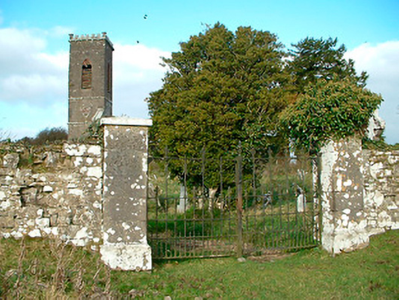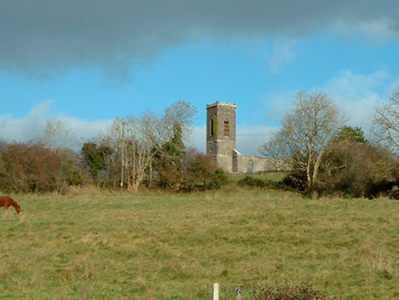Survey Data
Reg No
15401116
Rating
Regional
Categories of Special Interest
Architectural, Artistic, Social
Original Use
Church/chapel
Date
1810 - 1820
Coordinates
237471, 262433
Date Recorded
05/11/2004
Date Updated
--/--/--
Description
Freestanding Church of Ireland church, built c.1817, comprising four-bay hall with attached three-stage tower on square-plan to the west with a raised parapet with English-style crenellations. Later nineteenth century single-storey chancel and vestry to east. Now out of use. Originally with pitched roof (now missing) with raised limestone verges. Roughcast rendered walls with projecting cut stone string courses to tower. Snecked limestone construction to chancel. Pointed-arched window openings with cut stone sills and remains of stained glass windows. Triple-light Geometric window to east gable. Pointed segmental-headed doorcase to south face of tower with chamfered cut limestone surrounds. Round opening over to first stage of tower containing timber quatrefoil and pointed-arched openings above to belfry with remains of timber Y-tracery and timber louvered vents. Set back from the road in own grounds and surrounded by graveyard with mostly nineteenth century grave markers. Rubble stone boundary wall encloses the church and associated graveyard with a pair of decorative cast-iron gates mounted on square cut stone piers. Built in a very prominent position on hill overlooking the village of Bunbrosna with associated rectory to northwest.
Appraisal
An attractive early nineteenth-century Church of Ireland church, built in a subdued Gothic style, which retains its early form, character and fabric despite its derelict condition. Its layout is typical of the standard hall and tower church, which were built in great numbers, particularly between 1808-1830, using loans and grants from the Board of First Fruits (1722-1833). These small, simple, but well-built churches have become almost iconographic features of the rural Irish countryside. This church was built in 1817 using a loan of £350 from the Board of First Fruits and the later Ecclesiastical Commissioners granted £129 towards its repair c.1835. Beautifully positioned in an elevated position, this modest ruin adds incident to the local skyline and is an integral element of the architectural heritage of Westmeath.







